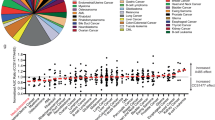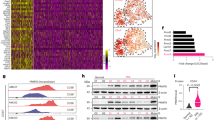Abstract
Our recent study demonstrated miR-15a/16-1 downregulation in mantle cell lymphoma (MCL). Here, we investigated mechanisms of miR-15a/16-1 transcriptional repression and its epigenetic regulation by c-Myc and histone deacetylase (HDAC) in MCL. c-Myc expression was detected in MCL cell lines and in the primary MCL samples, and pri-miR-15a/16-1 mRNAs were significantly upregulated in Mino and Jeko-1 cells with c-Myc knockdown by small interfering RNAs (siRNAs). Our co-immunoprecipitation analysis showed that c-Myc interacted with HDAC3. Moreover, using chromatin immunoprecipitation, we demonstrated that both c-Myc and HDAC3 co-localized to the two promoters of the miR-15a/16-1 cluster gene, DLEU2, and inhibition of HDAC3 increased histone acetylation of the DLEU2 promoters. Luciferase reporter assay confirmed the dependence of Myc-mediated DLEU2 transcriptional repression on HDAC3. Treatment with the pan-HDAC inhibitor, suberoylanilide hydroxamic acid and HDAC3 siRNA resulted in increased miR-15a/16-1 expression. The regulatory mechanism of miR-15a/16-1 was further demonstrated in Burkitt lymphoma and Myc overexpressing cell lines. These findings highlight the role of HDAC3 in Myc-induced miR-15a/16-1 changes and reveal novel mechanisms for c-Myc-driven microRNA suppression and malignant transformation in aggressive B-cell malignancies.
This is a preview of subscription content, access via your institution
Access options
Subscribe to this journal
Receive 50 print issues and online access
$259.00 per year
only $5.18 per issue
Buy this article
- Purchase on Springer Link
- Instant access to full article PDF
Prices may be subject to local taxes which are calculated during checkout



Similar content being viewed by others

References
Aqeilan RI, Calin GA, Croce CM . (2010). miR-15a and miR-16-1 in cancer: discovery, function and future perspectives. Cell Death Differ 17: 215–220.
Bandi N, Zbinden S, Gugger M, Arnold M, Kocher V, Hasan L et al. (2009). miR-15a and miR-16 are implicated in cell cycle regulation in a Rb-dependent manner and are frequently deleted or down-regulated in non-small cell lung cancer. Cancer Res 69: 5553–5559.
Barrans S, Crouch S, Smith A, Turner K, Owen R, Patmore R et al. (2010). Rearrangement of MYC is associated with poor prognosis in patients with diffuse large B-cell lymphoma treated in the era of rituximab. J Clin Oncol 28: 3360–3365.
Bhalla KN . (2005). Epigenetic and chromatin modifiers as targeted therapy of hematologic malignancies. J Clin Oncol 23: 3971–3993.
Bonci D, Coppola V, Musumeci M, Addario A, Giuffrida R, Memeo L et al. (2008). The miR-15a-miR-16-1 cluster controls prostate cancer by targeting multiple oncogenic activities. Nat Med 14: 1271–1277.
Bottoni A, Piccin D, Tagliati F, Luchin A, Zatelli MC, degli Uberti EC . (2005). miR-15a and miR-16-1 down-regulation in pituitary adenomas. J Cell Physiol 204: 280–285.
Calin GA, Dumitru CD, Shimizu M, Bichi R, Zupo S, Noch E et al. (2002). Frequent deletions and down-regulation of micro- RNA genes miR15 and miR16 at 13q14 in chronic lymphocytic leukemia. Proc Natl Acad Sci USA 99: 15524–15529.
Chang TC, Yu D, Lee YS, Wentzel EA, Arking DE, West KM et al. (2008). Widespread microRNA repression by Myc contributes to tumorigenesis. Nat Genet 40: 43–50.
Croce CM . (2009). Causes and consequences of microRNA dysregulation in cancer. Nat Rev Genet 10: 704–714.
Davidson-Moncada J, Papavasiliou FN, Tam W . (2010). MicroRNAs of the immune system: roles in inflammation and cancer. Ann NY Acad Sci 1183: 183–194.
Frank SR, Schroeder M, Fernandez P, Taubert S, Amati B . (2001). Binding of c-Myc to chromatin mediates mitogen-induced acetylation of histone H4 and gene activation. Genes Dev 15: 2069–2082.
Garzon R, Marcucci G, Croce CM . (2010). Targeting microRNAs in cancer: rationale, strategies and challenges. Nat Rev Drug Discov 9: 775–789.
Haberland M, Montgomery RL, Olson EN . (2009). The many roles of histone deacetylases in development and physiology: implications for disease and therapy. Nat Rev Genet 10: 32–42.
Han L, Witmer PD, Casey E, Valle D, Sukumar S . (2007). DNA methylation regulates microRNA expression. Cancer Biol Ther 6: 1284–1288.
Hartmann E, Fernandez V, Moreno V, Valls J, Hernandez L, Bosch F et al. (2008). Five-gene model to predict survival in mantle-cell lymphoma using frozen or formalin-fixed, paraffin-embedded tissue. J Clin Oncol 26: 4966–4972.
Hernandez L, Hernandez S, Bea S, Pinyol M, Ferrer A, Bosch F et al. (1999). c-myc mRNA expression and genomic alterations in mantle cell lymphomas and other nodal non-Hodgkin's lymphomas. Leukemia 13: 2087–2093.
Kurland JF, Tansey WP . (2008). Myc-mediated transcriptional repression by recruitment of histone deacetylase. Cancer Res 68: 3624–3629.
Lee EM, Shin S, Cha HJ, Yoon Y, Bae S, Jung JH et al. (2009). Suberoylanilide hydroxamic acid (SAHA) changes microRNA expression profiles in A549 human non-small cell lung cancer cells. Int J Mol Med 24: 45–50.
Lerner M, Harada M, Loven J, Castro J, Davis Z, Oscier D et al. (2009). DLEU2, frequently deleted in malignancy, functions as a critical host gene of the cell cycle inhibitory microRNAs miR-15a and miR-16-1. Exp Cell Res 315: 2941–2952.
Liu T, Tee AE, Porro A, Smith SA, Dwarte T, Liu PY et al. (2007). Activation of tissue transglutaminase transcription by histone deacetylase inhibition as a therapeutic approach for Myc oncogenesis. Proc Natl Acad Sci USA 104: 18682–18687.
Marshall GM, Gherardi S, Xu N, Neiron Z, Trahair T, Scarlett CJ et al. (2010). Transcriptional upregulation of histone deacetylase 2 promotes Myc-induced oncogenic effects. Oncogene 29: 5957–5968.
Meyer N, Penn LZ . (2008). Reflecting on 25 years with MYC. Nat Rev Cancer 8: 976–990.
Nagy B, Lundan T, Larramendy ML, Aalto Y, Zhu Y, Niini T et al. (2003). Abnormal expression of apoptosis-related genes in haematological malignancies: overexpression of MYC is poor prognostic sign in mantle cell lymphoma. Br J Haematol 120: 434–441.
O'Donnell KA, Wentzel EA, Zeller KI, Dang CV, Mendell JT . (2005). c-Myc-regulated microRNAs modulate E2F1 expression. Nature 435: 839–843.
Pajic A, Spitkovsky D, Christoph B, Kempkes B, Schuhmacher M, Staege MS et al. (2000). Cell cycle activation by c-myc in a Burkitt lymphoma model cell line. Int J Cancer 87: 787–793.
Robertus JL, Kluiver J, Weggemans C, Harms G, Reijmers RM, Swart Y et al. (2010). MiRNA profiling in B non-Hodgkin lymphoma: a MYC-related miRNA profile characterizes Burkitt lymphoma. Br J Haematol 149: 896–899.
Savage KJ, Johnson NA, Ben-Neriah S, Connors JM, Sehn LH, Farinha P et al. (2009). MYC gene rearrangements are associated with a poor prognosis in diffuse large B-cell lymphoma patients treated with R-CHOP chemotherapy. Blood 114: 3533–3537.
Sotillo E, Laver T, Mellert H, Schelter JM, Cleary MA, McMahon S et al. (2011). Myc overexpression brings out unexpected antiapoptotic effects of miR-34a. Oncogene 30: 2587–2594.
Zhao JJ, Lin J, Lwin T, Yang H, Guo J, Kong W et al. (2010). microRNA expression profile and identification of miR-29 as a prognostic marker and pathogenetic factor by targeting CDK6 in mantle cell lymphoma. Blood 115: 2630–2639.
Acknowledgements
We are grateful to the Tissue Procurement, Molecular Core Laboratory and Flow Cytometry Core Facilities at H Lee Moffitt Cancer Center for providing specimens and molecular analysis. We thank Rasa Hamilton for editorial assistance. This work was supported by grants from the National Cancer Institutes (R01 CA137123, to JT), Maher Fund (to JT) and Moffitt Cancer Center Foundation (to JT).
Author contributions: XZ and XC designed and performed all of the experiments and contributed to manuscript preparation; ES and KW provided essential reagents and intellectual support; JL, TL and GW contributed to miRNA and ChIP analysis. ES, LM, WD, KW and JT provided clinical samples, information and intellectual support; XZ and JT designed experiments, interpreted data and wrote the manuscript.
Author information
Authors and Affiliations
Corresponding author
Ethics declarations
Competing interests
The authors declare no conflict of interest.
Additional information
Supplementary Information accompanies the paper on the Oncogene website
Supplementary information
Rights and permissions
About this article
Cite this article
Zhang, X., Chen, X., Lin, J. et al. Myc represses miR-15a/miR-16-1 expression through recruitment of HDAC3 in mantle cell and other non-Hodgkin B-cell lymphomas. Oncogene 31, 3002–3008 (2012). https://doi.org/10.1038/onc.2011.470
Received:
Revised:
Accepted:
Published:
Issue Date:
DOI: https://doi.org/10.1038/onc.2011.470
Keywords
This article is cited by
-
HDAC3-dependent transcriptional repression of FOXA2 regulates FTO/m6A/MYC signaling to contribute to the development of gastric cancer
Cancer Gene Therapy (2021)
-
Integrative data modeling from lung and lymphatic cancer predicts functional roles for miR-34a and miR-16 in cell fate regulation
Scientific Reports (2020)
-
Downregulation of miR-16 via URGCP pathway contributes to glioma growth
Scientific Reports (2017)
-
Unification of de novo and acquired ibrutinib resistance in mantle cell lymphoma
Nature Communications (2017)
-
RETRACTED ARTICLE: CDK4 and miR-15a comprise an abnormal automodulatory feedback loop stimulating the pathogenesis and inducing chemotherapy resistance in nasopharyngeal carcinoma
BMC Cancer (2016)


